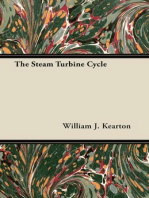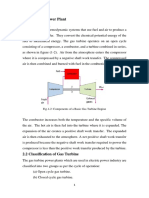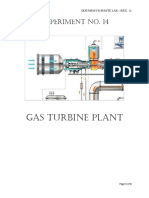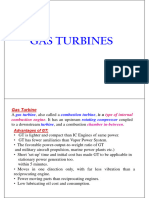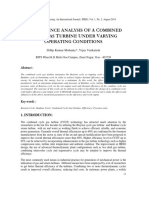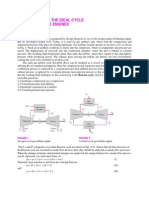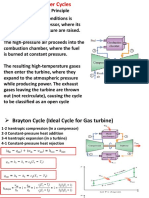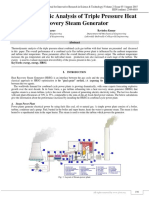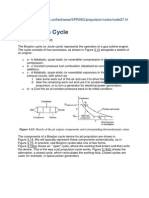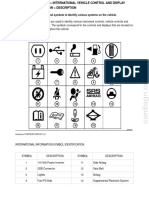18me42 Atd Module 2
18me42 Atd Module 2
Uploaded by
Shaik SulemanCopyright:
Available Formats
18me42 Atd Module 2
18me42 Atd Module 2
Uploaded by
Shaik SulemanOriginal Description:
Copyright
Available Formats
Share this document
Did you find this document useful?
Is this content inappropriate?
Copyright:
Available Formats
18me42 Atd Module 2
18me42 Atd Module 2
Uploaded by
Shaik SulemanCopyright:
Available Formats
Applied Thermodynamics (18ME42) 2019-2020
Module-2 Gas Power Cycles
2.1 Gas turbine cycles
• Turbine is a machine which extracts power from flowing fluids.
• In a gas turbine, gases at high-pressure and high-temperature are expanded through several
stages to produce power.
• Gas turbine power plants are used for aviation applications and power generation.
Advantages of gas turbines
• Higher power-to-weight ratio compared to reciprocating engines
• Smaller size for the same power produced.
• Lower emission levels.
• High rotational speed.
Disadvantages of gas turbines
• More expensive.
• Consumes more fuel during idling.
• Works best at constant load than fluctuating loads.
2.2 Open cycle gas turbine power plant (Joule cycle)
VTUPulse.com
Fig.1 Schematic diagram of open cycle gas turbine power plant
Fig.2 p-V and T-s diagrams of open cycle gas turbine power plant
Department of Mechanical Engineering, GMIT, Bharathinagara Page 1
Applied Thermodynamics (18ME42) 2019-2020
The open cycle gas turbine power plant, also referred to as Joule cycle, and is shown
schematically in Fig. 1 The p-V and T-s diagrams are shown in Fig.2 The working of open
cycle gas turbine power plant is explained as follows:
• Process 1-2: Isentropic or reversible adiabatic compression
Air is taken from the atmosphere by the compressor and compresses isentropically to
pressure p2 and temperature T2.
• Process 2-3: Constant pressure heat supply
The high pressure and temperature air enters the combustion chamber wherein the fuel is
supplied. The fuel is burnt in the presence of hot air and the combustion gases are produced.
The pressure and temperature of the combustion gases increases to p3 and T3 respectively.
• Process 3-4: Isentropic or reversible adiabatic expansion
The high-pressure and high-temperature combustion gases enter a turbine where it expands to
a low-pressure (equal to or a little above the atmospheric pressure) gas.
• Process 4-1: Constant volume heat supply
The exhaust gases are released to the surroundings. The dashed line 4-1 represents that the
cycle is open.
2.3 Closed cycle gas turbine power plant (Brayton cycle)
• Closed Cycle is the air-standard cycle of an actual gas turbine plant where the combustion
VTUPulse.com
and exhaust of gases are replaced by constant pressure heat addition and heat rejection
processes.
• The ideal cycle in which the working fluid (air) undergoes thermodynamic processes in a
closed loop to produce the net power is the Brayton Cycle.
Advantages of closed cycle gas turbine power plant
1. The use of higher pressure throughout the cycle reduces the plant size for a given output.
2. It avoids corrosion and erosion of turbine blades due to contaminated gases as indirect
heating is used in the cycle.
3. No requirement of filtration of incoming air.
4. Cheap solid fuels like coal, wood can be economically used.
5. Low maintenance cost and high reliability.
Disadvantages of closed cycle gas turbine power plant
1. This cycle is not suitable for air craft applications as huge quantity of cooling water is
required in the cooler.
2. The weight of the plant per unit of power developed is high.
3. It uses a large air-heater compared to combustion chamber of open cycle, because heat
transfer coefficient in the heat exchanger is low.
4. The installation cost is high.
Department of Mechanical Engineering, GMIT, Bharathinagara Page 2
Applied Thermodynamics (18ME42) 2019-2020
2.4 Ideal Brayton cycle (Closed Cycle)
An ideal Brayton cycle consists of two reversible adiabatic (isentropic) processes and
two constant pressure (isobaric) processes. These thermodynamic processes are executed in
steady flow devices in cyclic order.
VTUPulse.com
Fig.3 Schematic diagram of closed cycle gas turbine power plant
Fig.4 p-V & T-S diagram of closed cycle gas turbine power plant
Department of Mechanical Engineering, GMIT, Bharathinagara Page 3
Applied Thermodynamics (18ME42) 2019-2020
The closed cycle gas turbine power plant, also referred to as Brayton cycle, is schematically
shown in Fig.3 The thermodynamic processes comprising the Brayton cycle are plotted on p-
V and T-s planes as shown in Fig. 4 The working of the cycle is explained as follows:
Process 1-2: Isentropic or reversible adiabatic compression in a compressor
The working fluid (air) enters the compressor at state 1 and is compressed isentropically
(Rev.Adiabatic) to state 2.
Process 2-3: Isobaric or constant pressure heat supply
The high-pressure air then enters the heat exchanger where the heat is added to the air from
an external source.
Process 3-4: Isentropic or reversible adiabatic expansion in a Turbine
The high-pressure and high-temperature air at state 3 is expanded isentropically (Rev.
Adiabatic) to state 4 by a turbine producing the work.
Process 4-1: Isobaric or constant pressure heat rejection
The low-pressure and low-temperature air enters the heat exchanger at state 4 and the heat is
rejected to an external sink. The air leaves the heat exchanger at state 1 and re-enters the
compressor, thus completing the cycle.
VTUPulse.com
2.5 Thermodynamic analysis of an ideal Brayton cycle
Department of Mechanical Engineering, GMIT, Bharathinagara Page 4
Applied Thermodynamics (18ME42) 2019-2020
VTUPulse.com
Observe that the thermal efficiency of an ideal Brayton gas turbine cycle increases with the
pressure ratio.
2.6 Effect of pressure ratio on work output of Brayton cycle
Fig.5 T-s diagram showing the effect of pressure ratio
Department of Mechanical Engineering, GMIT, Bharathinagara Page 5
Applied Thermodynamics (18ME42) 2019-2020
• T-s plot of Brayton cycle working between fixed temperature limits and increasing
pressure ratio is shown in Fig.5.
• It is observed that the net work output per cycle increases with the pressure ratio,
reaches a maximum, and then starts to decrease.
• Area 1-2-3-4 gives the maximum work output.
2.7 Optimum pressure ratio for maximum work output
VTUPulse.com
Department of Mechanical Engineering, GMIT, Bharathinagara Page 6
Applied Thermodynamics (18ME42) 2019-2020
2.8 Deviation of actual cycle from an ideal Brayton cycle
VTUPulse.com
Fig.6. T-s diagram showing the deviation of actual cycle
1. The compression and expansion processes are not isentropic. There is an increase in
entropy at the end of each process.
2. Due to this, the actual work input to the compressor is more, and the actual work output
from the turbine is less. The actual compression and expansion processes are shown by 1-
2’ and 3-4’ in Fig.6.
3. This deviation is accounted by defining the ‘isentropic efficiency’ of compressor and
turbine.
4. There is a small pressure drop in the heat addition (from p2 to p3) and heat rejection (from
p4 to p1) processes due to frictional effects.
Department of Mechanical Engineering, GMIT, Bharathinagara Page 7
Applied Thermodynamics (18ME42) 2019-2020
VTUPulse.com
Department of Mechanical Engineering, GMIT, Bharathinagara Page 8
Applied Thermodynamics (18ME42) 2019-2020
VTUPulse.com
2.9 Methods for improving work output (thermal efficiency) of Brayton cycle
The following are the three methods to improve the work output (or thermal efficiency) of a
Brayton cycle:
(i) Regeneration:
Utilisation of heat present in exhaust gases to pre-heat the air supplied to the
combustion chamber.
(ii) Intercooling:
Cooling the air compressed in first stage to the initial temperature before it is sent to
the second stage compressor. This results in reducing the work input to the multi-stage
compressor.
(iii) Reheating:
Heating the air expanded in first stage to the maximum cycle temperature before it is
sent to the second stage turbine. This results in increasing the work output of the multi-stage
turbine.
Department of Mechanical Engineering, GMIT, Bharathinagara Page 9
Applied Thermodynamics (18ME42) 2019-2020
2.10 Regeneration
VTUPulse.com Fig: 7 Schematic diagram regeneration cycle.
Department of Mechanical Engineering, GMIT, Bharathinagara Page 10
Applied Thermodynamics (18ME42) 2019-2020
2.11 Intercooling
VTUPulse.com
Fig.8. Schematic diagram of intercooling cycle.
• Fig.8. Shows a schematic diagram of intercooling cycle.
• Multi-stage compression of air to the required pressure ratio with intercooling reduces the
work input to the compressor to a maximum extent.
• Thus, the net work output of the gas turbine plant is increased.
• The air, after first stage compression, is cooled in an ideal heat exchanger (intercooler) to
the initial temperature of air (T3 = T1 )
• For the same turbine work output, the work supplied to the compressor is reduced. Thus, the
net work output of the cycle is increased.
• However, the heat supplied to the combustion chamber is increased. Hence, the thermal
efficiency of the cycle is reduced.
Department of Mechanical Engineering, GMIT, Bharathinagara Page 11
Applied Thermodynamics (18ME42) 2019-2020
2.12 Optimum Intercooling Pressure for Minimum Work Input
VTUPulse.com
Department of Mechanical Engineering, GMIT, Bharathinagara Page 12
Applied Thermodynamics (18ME42) 2019-2020
VTUPulse.com
2.13 Reheating
Fig.9. Schematic diagram of reheating cycle
• The schematic diagram of a reheating cycle is shown in Fig.9.
Department of Mechanical Engineering, GMIT, Bharathinagara Page 13
Applied Thermodynamics (18ME42) 2019-2020
• The work output of a turbine operating between two pressure limits can be increased by
expanding the gas in stages and reheating it in between.
• This is accomplished without raising the maximum temperature in the cycle.
• The reheating can be accomplished by spraying additional fuel into the oxygen-rich exhaust
gases between two expansion states.
• Ideally, the reheating is done in such a way that the temperature of the gases after the first
expansion is raised to that of the maximum cycle temperature.
• As the number of stages is increased, the expansion process becomes nearly isothermal.
• Although reheating results in increased specific work output, this gain is achieved with the
expense of efficiency because of the additional heat supply.
2.14 Optimum reheat pressure for maximum work output
VTUPulse.com
Department of Mechanical Engineering, GMIT, Bharathinagara Page 14
Applied Thermodynamics (18ME42) 2019-2020
VTUPulse.com
Department of Mechanical Engineering, GMIT, Bharathinagara Page 15
Applied Thermodynamics (18ME42) 2019-2020
Numerical examples on methods of improving Brayton cycle efficiency
VTUPulse.com
Department of Mechanical Engineering, GMIT, Bharathinagara Page 16
Applied Thermodynamics (18ME42) 2019-2020
VTUPulse.com
Department of Mechanical Engineering, GMIT, Bharathinagara Page 17
Applied Thermodynamics (18ME42) 2019-2020
2.15 Introduction to the principles of jet propulsion
• Gas turbine cycles used to power aircraft engines are known as “jet-propulsion” cycles.
• In an ideal jet-propulsion cycle, the gases are not expanded to the ambient pressure in the
turbine, as in the case of an ideal Brayton cycle.
• Instead, the gases are expanded to a pressure such that the power produced by the turbine is
just sufficient to drive the compressor and the auxiliary equipment (such as small generator,
pump, etc.,)
• Thus, the net work output of a jet-propulsion cycle is zero.
• The gases coming out of the turbine at high pressure are subsequently accelerated in a
nozzle to provide the thrust to propel the aircraft.
2.16 Classification of gas turbine engines for jet propulsion
The thrust force required for propulsion can be obtained by either propelling a large mass of
air or by increasing the velocity of a small mass of air. Based on this principle, gas turbine
engines for jet propulsion are classified as:
• Turbo-jet Engine
VTUPulse.com
Turbo-prop Engine
Turbo-fan Engine
• Ram-jet engine
Pulse-jet engine
2.17 Ideal turbojet cycle:
Fig.10. Schematic diagram of an ideal turbojet engine.
Department of Mechanical Engineering, GMIT, Bharathinagara Page 18
Applied Thermodynamics (18ME42) 2019-2020
10
VTUPulse.com
2.18 Advantages and Disadvantages of turbo-jet engine
Advantages:
• Simple in construction and easy to maintain.
• Occupies less space.
• Attain higher flight speeds (800 to 1000 kmph)
• Rate of climb is higher.
• A wide variety of fuels can be used.
• Performance is not affected very much by A/F ratio used.
Disadvantages:
• Materials used are costlier and have shorter life.
• Produces more noise.
• Requires a long run-way, if the take-off period is higher.
• Specific fuel consumption is higher at low altitudes.
Department of Mechanical Engineering, GMIT, Bharathinagara Page 19
Applied Thermodynamics (18ME42) 2019-2020
2.19 Turboprop (Propjet) engine
Fig: 11 Schematic diagram of a turboprop engine.
• A turboprop engine is shown schematically in Fig. 11.
• A turbo-prop engine differs from turbo-jet engine in that it uses a propeller to increase the
VTUPulse.com
mass flow of air entering the diffuser. This increases the higher thrust per mass flow of fuel
and also results in better fuel economy.
• The working of the engine is similar to a turbo-jet engine.
• Nearly 80% the expansion takes place in the turbine in order to run the compressor and
propeller.
• The gas turbine speed being very high, a reduction gear is used to run the propeller.
2.20 Advantages and disadvantages of turbo-prop engine
Advantages:
• Provides higher thrust at take-off and better fuel economy.
• Operates most economically over a wide range of speed (400 to 800 kmph).
• Maintenance is easy and it has lower vibration and noise.
• The drag is less because of less frontal area.
Disadvantages:
• Lower propeller efficiency at higher speeds due to shock and flow separation.
• Reduction gear is essential which increases maintenance cost and loss of energy due to gear
friction.
Department of Mechanical Engineering, GMIT, Bharathinagara Page 20
Applied Thermodynamics (18ME42) 2019-2020
2.21 Turbofan (Fanjet or Bypass Turbojet) engine
Fig: Schematic diagram of a turbofan engine.
• It is a modification of turbojet engine which is most widely used in aircraft propulsion.
• In this engine, a large fan driven by the turbine forces a considerable amount of air through
a duct (cowl) to the exhaust unit, bypassing the engine.
VTUPulse.com
• A portion of air is sent to the engine compressor adding an advantage of creating
supercharging effect.
• The fan exhaust leaves the duct at a higher velocity, enhancing the total thrust of the engine
significantly.
• In this engine, the high-speed exhaust gases are mixed with the lower-speed air, which
results in a considerable reduction in noise.
2.22 Ramjet engine (Lorin tube)
Fig: Schematic diagram of a ramjet engine
Department of Mechanical Engineering, GMIT, Bharathinagara Page 21
Applied Thermodynamics (18ME42) 2019-2020
VTUPulse.com
2.23 Advantages and disadvantages of ram-jet engine
Advantages:
• Very simple and has no moving parts. Light in weight and maintenance-free.
• Any type of liquid fuel can be used.
• High temperature of the gases causes no danger since there is no turbine.
• Specific fuel consumption is lower than any other jet engines, in particular, at high speed
and high altitude.
Disadvantages:
• Take-off thrust is zero, as air compression is achieved by ramming action. A small turbojet
is required for starting the Ram-jet.
• The design of diffuser is very critical.
• Special flam stabilization techniques are needed in the combustion chamber to handle very
high speed air.
• Due to very high temperatures, there is danger of dissociation of combustion products in the
combustion chamber.
• Preferred only for high speed military aircrafts and missiles.
Department of Mechanical Engineering, GMIT, Bharathinagara Page 22
Applied Thermodynamics (18ME42) 2019-2020
2.24 Pulse-jet engine
Fig: Schematic diagram of a pulse-jet engine.
• Pulse-jet resembles a ram-jet except that it has shutter valves which make the process of air
induction intermittent.
• The pulse-jet was developed in Germany during the World War II and its operating cycle
may be compared with Otto cycle and is self-starting.
• The incoming air is compressed in the diffuser and the high pressure air enters the
VTUPulse.com
combustion chamber through the shutter valves.
• The fuel injected in the combustion chamber is burnt by the ignitor (or spark plug) and
consequent rise in pressure closes the shutter valves, making the combustion process to occur
at constant volume.
• The high pressure and high temperature gases expand through the nozzle producing the
required thrust.
• After the gases leave the combustion chamber, the pressure decreases and the shutter valves
open to allow the compressed air again. The air mixes with fuel and cycle repeats.
• Once the engine starts operating normally, the ignitor (or spark plug) is switched off and the
residual flame inside the combustion chamber from the previous explosion is used for
ignition in the succeeding cycles.
• Pulse-jet engines are much cheaper than Ram-jet engines and are self-starting. But, the
propulsive efficiency is lower.
Department of Mechanical Engineering, GMIT, Bharathinagara Page 23
You might also like
- Repair Manual 7572516-040: WWW - Cesab.itDocument524 pagesRepair Manual 7572516-040: WWW - Cesab.itDanatas SapožnikovasNo ratings yet
- Site Visit Report - Se HauDocument8 pagesSite Visit Report - Se HauLiew Yu LoengNo ratings yet
- (0005) Engine Failure Analysis BookletDocument44 pages(0005) Engine Failure Analysis Bookletasil mokhamadNo ratings yet
- ECU 80to121 Upd2Document9 pagesECU 80to121 Upd2Edward MainaNo ratings yet
- Fluid Mechanics Gas Turbine Module 2Document23 pagesFluid Mechanics Gas Turbine Module 2Shweta PanalkarNo ratings yet
- Gas Turbine Power Plant: Fig.1-2: Components of A Basic Gas Turbine EngineDocument22 pagesGas Turbine Power Plant: Fig.1-2: Components of A Basic Gas Turbine Engineام البنين الرياني100% (2)
- Unit 3 Gas Turbines AND JET PROPULSIONDocument99 pagesUnit 3 Gas Turbines AND JET PROPULSIONSANTHOSH NAGARAJANo ratings yet
- Gas Turbines and Its ModificationsDocument29 pagesGas Turbines and Its ModificationsHamza NeweraNo ratings yet
- Cycle Gas Turbine (1)Document16 pagesCycle Gas Turbine (1)edwinwaithaka746No ratings yet
- Pplied: ThermodynamicsDocument86 pagesPplied: ThermodynamicsAlaa Shammaa100% (1)
- ProgressDocument29 pagesProgressVictor BettNo ratings yet
- 14 Gas Turbine PlantDocument4 pages14 Gas Turbine PlantAshwini SinghNo ratings yet
- Brayton CycleDocument12 pagesBrayton CycleVinoth KumarNo ratings yet
- Engineering Software: Brayton Cycle (Gas Turbine) For Propulsion Application AnalysisDocument16 pagesEngineering Software: Brayton Cycle (Gas Turbine) For Propulsion Application AnalysisagoezNo ratings yet
- Chapter 3 - Thermodynamics of IC EngineDocument28 pagesChapter 3 - Thermodynamics of IC Enginesirawdinkgetachew15No ratings yet
- Gas TurbinesDocument22 pagesGas Turbineswayzodeneeraj100% (1)
- Plant Overview 7Document7 pagesPlant Overview 7vipulgupta2012No ratings yet
- 8.ME 169-Gas TurbinesDocument21 pages8.ME 169-Gas TurbinesMD MUSTAFANo ratings yet
- 1214meij02 PDFDocument15 pages1214meij02 PDFAnonymous 9JYURINo ratings yet
- Chapter 8B - Gas Power Plant Brayton CycleDocument17 pagesChapter 8B - Gas Power Plant Brayton CycleBF3nobel100% (1)
- Brayton CycleDocument5 pagesBrayton CycleDanang Wahdiat Aulia IshaqNo ratings yet
- Performance and aplications gas turbines in aviationDocument7 pagesPerformance and aplications gas turbines in aviationnicolas.ignaciotoromoscosoNo ratings yet
- Expt. 02 Stusy of A Gas Turbine Power PlantDocument5 pagesExpt. 02 Stusy of A Gas Turbine Power PlantSajeeb SarkerNo ratings yet
- Gas Turbine MaintenanceDocument146 pagesGas Turbine MaintenanceMamoun1969100% (12)
- Gas Turbine Cycles - LectureDocument18 pagesGas Turbine Cycles - LectureSrinu Reddy100% (2)
- Thermodynamics Lecture 6Document32 pagesThermodynamics Lecture 6MarkJude Morla100% (1)
- Gas TurbineDocument25 pagesGas TurbineMohammed AlsirajNo ratings yet
- Thermofluids & Engine: Gas Power CyclesDocument29 pagesThermofluids & Engine: Gas Power CyclesQim Sv100% (1)
- Brayton Cycle Reheat Regen RecollingDocument14 pagesBrayton Cycle Reheat Regen RecollingDaxit LodaliyaNo ratings yet
- Critically Evaluate The Modifications Made To TheDocument5 pagesCritically Evaluate The Modifications Made To Theelrefaimohamed293No ratings yet
- Unit 2 IC Engine CyclesDocument12 pagesUnit 2 IC Engine CyclesFrezer BelayNo ratings yet
- 06 Gas Turbine Power PlantDocument31 pages06 Gas Turbine Power PlantRishav niroula100% (1)
- Lec 15 16 - CH 9 BRAYTON TurbineDocument17 pagesLec 15 16 - CH 9 BRAYTON Turbinesamhameed2100% (1)
- Gas Turbine AssignmentDocument12 pagesGas Turbine Assignmentjojo joeNo ratings yet
- 1-Gas Turbine DesignDocument56 pages1-Gas Turbine DesignMohammed Yusuf100% (5)
- Shaft Power Cycle Presentation TraineeDocument44 pagesShaft Power Cycle Presentation TraineeCharles EbukaNo ratings yet
- 18ME42 ATD Module 1Document37 pages18ME42 ATD Module 1shreyadv5No ratings yet
- University of Karbala Department of Mechanical Lecture Notes - Power Plants by Fadhel Al-MousawiDocument27 pagesUniversity of Karbala Department of Mechanical Lecture Notes - Power Plants by Fadhel Al-Mousawiحامد عبد الشهيد حميد مجيد100% (2)
- Gas Power CycleDocument49 pagesGas Power CycleNafisa AnikaNo ratings yet
- Brayton CycleDocument15 pagesBrayton CycleWahyudin BetaNo ratings yet
- Thermodynamic Evaluation of The Performance of A Combined Cycle Power PlantDocument11 pagesThermodynamic Evaluation of The Performance of A Combined Cycle Power PlanthansleyNo ratings yet
- HKP Gas Turbine Power PlantsDocument46 pagesHKP Gas Turbine Power PlantsHarshad PatelNo ratings yet
- Engineering Software: Brayton Cycle (Gas Turbine) For Propulsion Application AnalysisDocument16 pagesEngineering Software: Brayton Cycle (Gas Turbine) For Propulsion Application AnalysisHeni HtiraNo ratings yet
- 6. gas Turbine cycleDocument32 pages6. gas Turbine cyclearijitsahashrabon1No ratings yet
- Stirling Cycle and The Ericsson Cycle. They Differ From The Carnot Cycle in That The TwoDocument2 pagesStirling Cycle and The Ericsson Cycle. They Differ From The Carnot Cycle in That The TwoannukiitNo ratings yet
- Gas TurbineDocument10 pagesGas Turbinerr1998773No ratings yet
- Brayton CycleDocument103 pagesBrayton CycleRoosevelt SantosNo ratings yet
- Gasturbine 161231093609Document23 pagesGasturbine 161231093609nailanadeem221No ratings yet
- Gas Turbine Working PrincipleDocument7 pagesGas Turbine Working PrincipleAhmed Mohamed SalihNo ratings yet
- Journal - Assignment 1Document9 pagesJournal - Assignment 1wanilham2002No ratings yet
- Gas Turbine System & PropulsionDocument35 pagesGas Turbine System & PropulsionnaveedsidhuNo ratings yet
- Thermodynamic Analysis of Triple Pressure Heat Recovery Steam GeneratorDocument7 pagesThermodynamic Analysis of Triple Pressure Heat Recovery Steam GeneratorIJIRST100% (2)
- 4.Gas Turbines (1)Document13 pages4.Gas Turbines (1)Ruturaj SuryawanshiNo ratings yet
- ME 444 - GT-2 - Part 2Document21 pagesME 444 - GT-2 - Part 2azoz173173173No ratings yet
- 4 3 CogenerationDocument10 pages4 3 CogenerationJayvin RossNo ratings yet
- Joule Brayton CycleDocument12 pagesJoule Brayton CyclecaptfoleyNo ratings yet
- Gas Turbine F1041 & F1065Document12 pagesGas Turbine F1041 & F1065syed arimiNo ratings yet
- Sustainable Energy Conversion for Electricity and Coproducts: Principles, Technologies, and EquipmentFrom EverandSustainable Energy Conversion for Electricity and Coproducts: Principles, Technologies, and EquipmentNo ratings yet
- Hybrid Systems Based on Solid Oxide Fuel Cells: Modelling and DesignFrom EverandHybrid Systems Based on Solid Oxide Fuel Cells: Modelling and DesignNo ratings yet
- Case Studies in Mechanical Engineering: Decision Making, Thermodynamics, Fluid Mechanics and Heat TransferFrom EverandCase Studies in Mechanical Engineering: Decision Making, Thermodynamics, Fluid Mechanics and Heat TransferRating: 5 out of 5 stars5/5 (2)
- Operator's Guide to General Purpose Steam Turbines: An Overview of Operating Principles, Construction, Best Practices, and TroubleshootingFrom EverandOperator's Guide to General Purpose Steam Turbines: An Overview of Operating Principles, Construction, Best Practices, and TroubleshootingRating: 5 out of 5 stars5/5 (1)
- CarDekho PDF Report SampleDocument9 pagesCarDekho PDF Report SamplerehmanNo ratings yet
- Understanding Crankshaft BalancingDocument5 pagesUnderstanding Crankshaft BalancingVontrex DergonNo ratings yet
- Combined Bounce, Pitch, and Roll Dynamics of Vehicles Negotiating Single Speed Bump EventsDocument8 pagesCombined Bounce, Pitch, and Roll Dynamics of Vehicles Negotiating Single Speed Bump EventsZibusiso NcubeNo ratings yet
- Internal Combustion Engine Quiz 1Document2 pagesInternal Combustion Engine Quiz 1Snunkhaem EcharojNo ratings yet
- Engine Coolant Temperature Sensor PM3516 3516B Power Module NBR00001-UP PDFDocument2 pagesEngine Coolant Temperature Sensor PM3516 3516B Power Module NBR00001-UP PDFFaresNo ratings yet
- Throttle Position Sensor Adjustment PDFDocument4 pagesThrottle Position Sensor Adjustment PDFDoDuyBacNo ratings yet
- Manual de Fusibles de Ford Windstar 1998Document3 pagesManual de Fusibles de Ford Windstar 1998Jose Eduardo Romero Gonzalez0% (1)
- Chapter 4-Electronic Fuel Injection (EFI)Document35 pagesChapter 4-Electronic Fuel Injection (EFI)Wybar Mujahid100% (1)
- Power Source Turn Signal and Hazard Warning Light (From Aug. 2006 Production)Document1 pagePower Source Turn Signal and Hazard Warning Light (From Aug. 2006 Production)dimaspangayomNo ratings yet
- Brosura Hitachi ZW250-6 ENDocument24 pagesBrosura Hitachi ZW250-6 ENGrigore VladNo ratings yet
- Yamaha F150aet Spare PartsDocument87 pagesYamaha F150aet Spare Partsarroas75100% (1)
- Supplier Debit ZL From Nov To AprilDocument133 pagesSupplier Debit ZL From Nov To AprilMUNENDRA SHAKYANo ratings yet
- WVWZZZ1KZ6W125243Document6 pagesWVWZZZ1KZ6W125243p42vw2z498No ratings yet
- Installation Instructions: Anti-Roll-KitDocument3 pagesInstallation Instructions: Anti-Roll-KitRodrigoNo ratings yet
- Caterpillar Part 2Document29 pagesCaterpillar Part 2lionkinghdNo ratings yet
- TSP 6500 7000 enDocument8 pagesTSP 6500 7000 enMahmoud ElerakyNo ratings yet
- Dodge Dart (PF)Document12 pagesDodge Dart (PF)Roberto Ortega MicalizziNo ratings yet
- Cce - WL - D Series - 721D - Specs - 07-20-2010 - 2 PDFDocument6 pagesCce - WL - D Series - 721D - Specs - 07-20-2010 - 2 PDFHelverNo ratings yet
- Summer Training Presentation Indian Railways - Carriage Workshop MatungaDocument15 pagesSummer Training Presentation Indian Railways - Carriage Workshop MatungaAmit YadavNo ratings yet
- HYUNDAI GT DymosTM - 12speedDocument30 pagesHYUNDAI GT DymosTM - 12speedkingtiger.bkNo ratings yet
- Manual de Serviço - Grand Cherokee - SM - 01 - 221116Document13 pagesManual de Serviço - Grand Cherokee - SM - 01 - 221116Cleyton C RibeiroNo ratings yet
- Ritz BrochureDocument6 pagesRitz BrochureVkc ArtsNo ratings yet
- Rexton Notice English VersionDocument242 pagesRexton Notice English Versionnkapnangluther3099No ratings yet
- 20157721-Wiring Diagram VMDocument110 pages20157721-Wiring Diagram VMvinyxxxNo ratings yet
- PTG1223 en WorkbookDocument31 pagesPTG1223 en WorkbookstealthdcNo ratings yet
- ICE MCQ 1Document7 pagesICE MCQ 1Ahmed WaheedNo ratings yet
- GES Equipment Report MT6020 Parts Package GuideDocument10 pagesGES Equipment Report MT6020 Parts Package GuideporometalNo ratings yet




